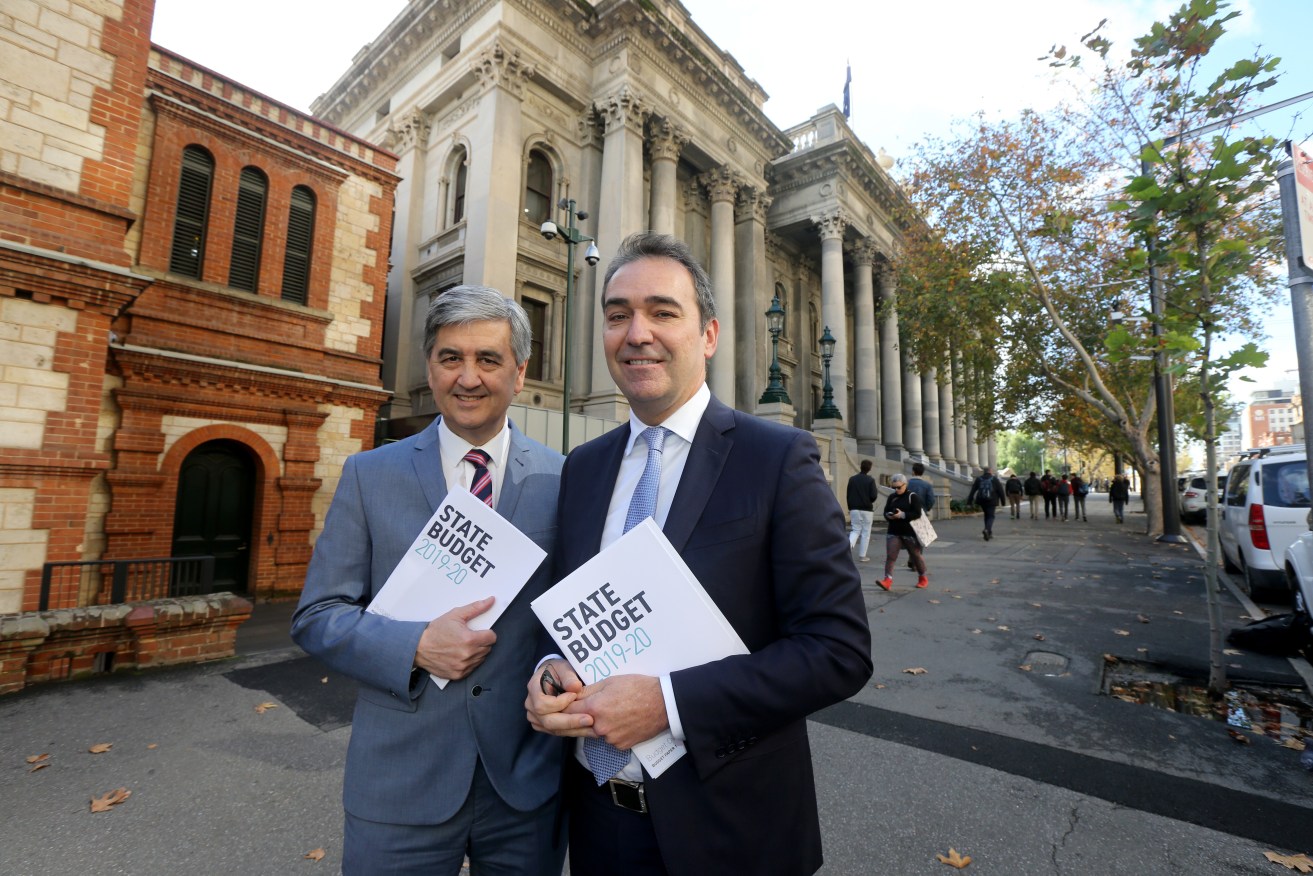Lucas’s land tax gambit: top rate slashed, but “loophole” fix remains
UPDATED | The Marshall Government will seek to avert a showdown with the top end of town and a backbench rebellion with an immediate reduction in the state’s top land tax rate, from 3.7 to 2.4 per cent – but it won’t ditch its push to close the contentious aggregation “loophole”.

SA Treasurer Rob Lucas and Premier Steven Marshall. Photo: Kelly Barnes / AAP
In a reform signed off by cabinet today and unveiled at a party-room meeting this evening, Treasurer Rob Lucas will take an axe to the top tax rate from July next year. If passed through parliament, the top rate will still be marginally above the national average and higher than Victoria and NSW, but below WA.
It’s understood Liberal MPs unanimously agreed to allow the measures to be released for further consultation, which will take place over the coming weeks, after the Government conceded it had bungled its estimates for the amount of revenue its forecast aggregation changes would reap – with the actual figure almost three times the budgeted $40 million.
Lucas said in a statement the revised changes meant the “overwhelming majority of ‘mum and dad’ investors and company groups will pay less land tax”, with the tax-free threshold already increasing from $391,000 to $450,000.
But the changes to aggregation, which will ensure property owners cannot use previously-legal measures such as trusts to offset their land tax burden, will remain.
“It is clearly unfair that someone can own $2 to 3 million in properties and yet not pay a single dollar in land tax,” Lucas said.
In total, $70 million less land tax revenue will be collected by the Government over the three years from 2020-21 to 2022-23, the Treasurer said.
“Just by increasing the tax-free threshold alone, more than 9,000 investors will no longer have to pay any land tax at all. In total, taxpayers will save $70 million over three years from our tax reform package,” he said.
“For far too long, South Australia has been in the unenviable position of having the nation’s highest top marginal land tax rate, which has acted as a disincentive to investment and strong economic growth.
“Some investors have for years been preferring investing in other states because of the uncompetitive nature of our 3.7 per cent top tax rate… our reform will release this hand-brake on investment attraction, further boost business and consumer confidence, create jobs and put more money back into the pockets of hardworking South Australians.”
Lucas’s aggregation changes have prompted a fierce response from the property sector and open mutiny on the backbench, but despite Lucas long pledging to reduce the top rate of land tax – a project that had been originally slated to take seven years to reach just 2.9 per cent – some in the party-room appear to have been mollified by the extent of the revised cut.
“This is a victory for commonsense,” one MP told InDaily.
“As far as I can see, the vast majority of people will be ok… there’ll still be some who will be really angry [but] it’s dramatically different, and dramatically improved – and thank goodness some of us stood up.”
Under the changes, 8 per cent or 4300 individuals and 25 per cent or 2600 company groups will pay more land tax.
But Lucas conceded he’d underestimated the revenue windfall from the aggregation changes – which were set to reap around $118 million a year, almost three times the $40 million forecast in June.
Gobsmacking that @marshall_steven and @Rob_Lucas could tell South Australians that land tax aggregation would raise $40m/year, when its now going to raise $118m/yr
— Stephen Mullighan MP (@SMullighan) September 9, 2019
With a new proposed top tax rate of 2.4 per cent, the aggregation changes will still raise an extra $86 million per year – more than twice what was forecast in the budget.
“We significantly underestimated but in the end we make a good story out of that by driving down the top rate to 2.4 – a good result in terms of significant reform,” Lucas said.
But the budget faux pas has not impressed some of his Liberal discontents, with one noting that $85 million would now be spread thinly across those 4300 individuals and 2600 company groups affected.
“I still don’t think they’ve solved their problems,” the insider said.
“That’s a lot of pain for those individuals and businesses.”
Property Council boss Daniel Gannon said tonight “while the Government’s appetite for a reduced top rate is welcomed, unfortunately its desire for aggregation changes remain intact as the Valuer-General is revaluing every property across the state”.
“If aggregation is still part of the plan, it’s not a plan that we support because it’s incomplete and underdone,” he said.
“Given the Government now accepts its $40 million revenue forecast was inaccurate, how can any investor – big or small – trust the latest figures and calculations?
“Statewide property revaluations will deliver $75 million every year if valuations increase by 10 per cent, let alone the tax tidal wave caused by changes to aggregation.”
UDIA chief Pat Gerace told InDaily “reducing the top rate is always welcome but there’s still a number of losers in this outcome, particularly those who will have little time to adjust to the aggregation changes”.




